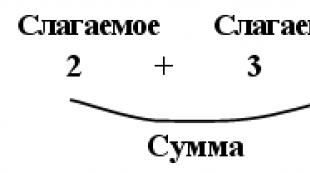Yellow crescent. Why do the moon and sun change color? Does the bloody moon somehow affect a person
Moon and sun
If you look at the Moon from space (you don't have to strain your imagination for this - there are pictures of the Moon taken by astronauts), then we will see a light gray ball, brightly illuminated by the Sun.
The Sun itself, against the background of the blackness of the cosmic abyss, looks dazzlingly white.
Moon color
If we look at the Moon from the Earth, then its color will change depending on its position in the sky. When the Moon rises above the horizon, it is a bright orange circle. The earth rotates on its axis. The moon rises higher and higher above the horizon, and its color gradually fades. The orange color turns to yellow, then to white-yellow. When the Moon is above the observer's head, its color becomes almost light gray.
Sun color
Something similar happens with the Sun. At noon, the sun is yellowish white. But at sunrise and sunset, it is red, orange or pink.
Related materials:
Full moon - interesting facts
Of course, neither the Moon nor the Sun actually change color. The clue is that we look at our luminaries through the thickness of the earth's atmosphere. Looking at the moon or the sun through the atmosphere is like looking through a veil. Light passes through the atmosphere before reaching our eyes. This long journey changes its spectral composition.
Nitrogen, oxygen and other gases that make up the air, dust particles suspended in it, smoke and other pollution in the atmosphere shift the spectrum of visible light to the red side.
Why does the color change?
Smoke, dust and other particles in the air shift the visible light spectrum towards the red. How does this happen? The sun emits white light. Moonlight, on the other hand, is just a reflection of the sun, so it is white too. But we know that sunlight is made up of all the colors of the rainbow. So, white sunlight carries all the colors of the rainbow as it flies towards Earth at a speed of 300 thousand kilometers per second. But then the light reached the earth's atmosphere. This is where miracles begin. Part of the sun's rays, without colliding with molecules of atmospheric gases, reaches earth surface in pristine purity and whiteness.
Related materials:
Interesting facts about the moon
During large forest fires, when puffs of smoke rise up into the sky for many days, the rising moon looks blood red and dawns are eerily beautiful. But most of the rays cannot avoid such a collision. When it happens, the light scatters. Mainly blue light is scattered. The rays of the remaining warm colors reach our eyes. Therefore, we see the Sun more yellow than it really is.
A distant mysterious planet, attracting the eyes of people, makes you think about its unusual properties. For centuries, mankind has been observing various natural factors, then clothe them in signs. And of course it would be impossible to pass by the phenomena, one way or another associated with the moon, promising joyful or sad events. Perhaps that is why she was always honored. Many peoples of the world bowed to her, offered thanks, asked for the essentials.
Mainly superstitions are associated with the new moon and full moon. Although, sometimes you can hear fearful tales about the bloody moon, bringing troubles.
If people got used to the yellow shade of the moon for a long time, then it is perceived in a completely different way in red tones. Signs point to very sad events: to be at war.
One of the biblical books says: "The Apocalypse will come when the sun turns into night and the moon turns into blood," that is, humanity is waiting for the end of the world.
 Still, you shouldn't be upset right away when you see a red disc. in the night sky. From the point of view of science, such a red color is the effect of optical refraction of light (alpha radiation), the essence of which is the shadow of the moon thrown onto the Earth.
Still, you shouldn't be upset right away when you see a red disc. in the night sky. From the point of view of science, such a red color is the effect of optical refraction of light (alpha radiation), the essence of which is the shadow of the moon thrown onto the Earth.
Will come true, won't come true
Many signs about the weather, fate or life are associated with the new moon.

Caring mistress of the night
This is how the moon can be called, which governs many earthly processes: the ebb, flow, growth and extinction of all living things. What would happen to earthlings if one day a night companion decided to leave us? The full moon is its maximum approach to the Earth, when the biorhythms of the living organism of our planet change.
 Such moments, of course, found echoes in popular superstitions and omens.
Such moments, of course, found echoes in popular superstitions and omens.
- If the rays moonlight fall on the face of a sleeping person, the latter will be tormented by nightmares. You should take care of the tranquility of a night's rest in advance by covering the window with a curtain;
- It is necessary to give up walking on the full moon, especially for children and pregnant women, as it attracts negative energy;
- The full moon attracts evil spirits, you should not show yourself at this time by the river or in the forest;
- It is not recommended to go to the full moon for operations or any other extraneous effect on the human body;
- The full moon lasts short period- 3 days, it is best not to start any global business during this phase. Not to appoint a wedding day, not to go on a tourist trip, not to start a serious conversation - it will most likely end in a quarrel out of the blue.
In this video, you can see the rituals performed on the full moon.
Very observant people probably noticed that the Moon does not always have the same color, and even its size can sometimes differ. However, not many people know about why the Moon changes these parameters. And today we will figure it out.
To begin with, it is worth saying that our satellite, of course, does not change its color and dimensions. The fact that we have the opportunity to observe it in different forms is only an optical illusion.
Why is the moon yellow
Quite often we have the opportunity to observe the Moon in yellow, and the first question with which we will understand is why the Moon is yellow.
It is important to understand that the original shade of our natural satellite- white-gray. As you know, the light emitted by the Moon is just a reflection of the sun's rays from the specific surface of our satellite. Immediately after being reflected on the surface of the Moon, the rays are sent to the Earth.
Here they are met by our atmosphere - the invisible armor of the planet. It is in the atmosphere that the rays are scattered, directed to the surface of the Earth from the Moon. And short waves are known to dissipate faster. These include blue colors. As for the yellow and red shades related to long waves, their scattering process is more complicated, and therefore we have the opportunity to observe the moon in yellow, and sometimes even red.
The same answer will be for the question of why the Sun is white and the Moon is yellow. However, the color of our natural luminary is really close to white, and after passing through the atmosphere we often see it yellowish.
By the way, with regard to the yellow color of the moon, the most probable possibility of observing a satellite in this range is on wet days, after rain. This is because the conditions of high humidity and pressure contribute to the absorption of light waves and the preservation of the yellow tint of the moon.
Why is the moon big and yellow
If with a question about yellow We figured out the moon, then it is also necessary to tell something about the change in the size of the natural satellite of our planet.
The fact is that during the movement of the Moon from the zenith to the horizon, the actual distance to our satellite increases by the size of our planet, which is why the satellite may seem much smaller.
As for the visual effect itself, when the moon is large and yellow, it can be observed during high humidity, as well as during the moon's "zenith".
To the question Why is the moon sometimes yellow and orange? given by the author Alex Gronovoy the best answer is If you look at the Moon from space (you don't have to strain your imagination for this - there are pictures of the Moon taken by astronauts), then we will see a light gray ball, brightly illuminated by the Sun. The Sun itself, against the background of the blackness of the cosmic abyss, looks dazzlingly white.
If we look at the Moon from the Earth, then its color will change depending on its position in the sky. When the Moon rises above the horizon, it is a bright orange circle. The earth rotates on its axis. The moon rises higher and higher above the horizon, and its color gradually fades. The orange color turns to yellow, then to white-yellow. When the Moon is above the observer's head, its color becomes almost light gray.
Something similar happens with the Sun. At noon, the sun is yellowish white. But at sunrise and sunset, it is red, orange or pink.
Of course, neither the Moon nor the Sun actually change color. The clue is that we look at our luminaries through the thickness of the earth's atmosphere. Looking at the moon or the sun through the atmosphere is like looking through a veil. Light passes through the atmosphere before reaching our eyes. This long journey changes its spectral composition.
Nitrogen, oxygen and other gases that make up the air, dust particles suspended in it, smoke and other pollution in the atmosphere shift the spectrum of visible light to the red side.
Smoke, dust and other particles in the air shift the visible light spectrum towards the red.
How does this happen? The sun emits white light. Moonlight, on the other hand, is just a reflection of the sun, so it is white too. But we know that sunlight is made up of all the colors of the rainbow. So, white sunlight carries all the colors of the rainbow as it flies towards Earth at a speed of 300 thousand kilometers per second. But then the light reached the earth's atmosphere. This is where miracles begin. Part of the sun's rays, without colliding with molecules of atmospheric gases, reaches the earth's surface in pristine purity and whiteness.
During large forest fires, when puffs of smoke rise up into the sky for many days, the rising moon looks blood red and dawns are eerily beautiful.
But most of the rays cannot avoid such a collision. When it happens, the light scatters. Mainly blue light is scattered. The rays of the remaining warm colors reach our eyes. Therefore, we see the Sun more yellow than it really is.
The Sun is closest to its natural color when it is at its zenith. The layer of atmospheric air that sunlight must pass through before entering the eye is thinner. Therefore, light scattering is less. When the Sun is near the horizon, its rays have to travel a long way through the lower dense layers of the atmosphere before being seen by an observer. Light on this thorny path, naturally, meets a mass of gas molecules and is strongly scattered. Therefore, the color of the rising and setting sun changes so dramatically. Molecules of gases in the atmosphere, particles suspended in it, scatter and absorb the rays of the blue part of the spectrum. This is the reason why we see the Sun as a hot orange ball at sunrise and sunset.
The same phenomena occur with the Moon. Therefore, at dusk, when the moon is not high above the horizon, its color is bright orange. Towards the night, when the moon rises high, its color becomes lighter. We can observe a more complete spectrum of moonlight, and therefore the Moon appears almost white to us. The more polluted the atmospheric air, the more colorful the Moon and the Sun look.
Why is the moon red?
The answer "Because the end of the world is coming soon" is not correct. It's all about the scattering of rays of sunlight. Usually the Moon reflects the full spectrum of colors coming from the Sun. And when they mix, we see a bright white disc in the sky. But if part of the spectrum is scattered as it passes through the Earth's atmosphere, one dominant color remains visible. And the most persistent shade is red.
2
The moon is close to the horizon
One of the most common cases is when the moon hangs low in the sky. This happens immediately after its rise or before setting over the horizon. That is, the same thing happens as during the rising and setting of the Sun. Light from the Moon, like the sun, passes through the layers of the atmosphere, and the closer it is to the horizon, the larger the area of "obstacles" it needs to overcome. In this case, part of the reflected light is scattered, which is why the Earth's satellite appears red.
3
Polluted atmosphere
Particles floating in the atmosphere can change the color of the moon visible to us. Especially a lot of them become from forest fires or volcanic eruptions, then they partially obscure the light from the Sun and the Moon. Blue and green spectra are scattered, while red passes through an obstacle much easier. So if the moon hangs high in the sky and looks red, it may be due to polluted air.
4
Moon eclipse
A case that has boggled the imagination of more than one generation: a blood-red satellite during a lunar eclipse. This always happens on a full moon: the moon goes into the shadow of the earth. This shadow, also called umber, darkens the satellite's surface.
In this position, only red light reaches the moon, which manages to break through the atmosphere of our planet - again, the matter is in the scattering of rays. Reflected from the surface of the moon, red light is visible to the naked eye. The effect is enhanced if the moon is hanging low above the horizon.
5
Why exactly red?
As it enters the Earth's atmosphere, sunlight collides with many particles that are less than the wavelength of light. This leads to the scattering of the rays. However, not all colors are scattered with the same intensity. Colors with shorter wavelengths, such as the violet spectrum, are scattered more than those with longer wavelengths - orange and red.
However, some of the colors in the blue spectrum do make it to the moon. Sometimes, at the very beginning of an eclipse and at its end, a blue or turquoise rim can be seen on the surface of the planet.
6
Why is the red moon paler than usual?
Do not forget that often the Moon turns red during an eclipse - the satellite is in the shadow of the Earth, which mutes the brightness of the glow. In addition, depending on the state of the earth's atmosphere, the color of its surface can take on various shades of red, orange or gold. The color of the border that appears at the beginning and end of an eclipse can also change.

The color gamut and brightness of the moon during an eclipse are measured on the Danjon Scale. It consists of five points: from 0 (the moon is almost invisible) to 4 (a very bright red or orange eclipse, a blue rim immediately appears).
7
When can you see the red moon?
Lunar eclipses take place in tetrads (series): 4 in a row, with a short interval between them - several months. But between the tetrads it can take more than 10 years. The first tetrad of the 21st century was held in 2003-2004. The second - in 2014 - 2015. The last red lunar eclipse of the second tetrad happened on September 28 this year ... oops! Already missed.
The next eclipse will open the third tetrad and it will happen on April 25, 2032.
Well, if you have neither the strength nor the desire to wait 17 years, then you can just watch the video and find out how it was.









